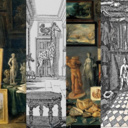Conference: Cabinet, Elaboratory, Gallery 1500-1800
The Preservation of Art and Material Culture in Europe
Registration Free.
The idea that the conservation and the material exploration of collected objects is mostly a twentieth century development has become disproportionately represented in the growing literature on the history of conservation. Great scientific advances in conservation and related materials analysis were made in nineteenth and twentieth centuries by various museum directors, conservators and chemists. These periods have emphatically delineated the marriage of science and conservation in the nineteenth and twentieth centuries as the dominant narrative. The legacy of earlier periods remains relatively unexplored in the scholarly output of art history, history and philosophy of science, and that of conservation. The early modern and modern periods offer many examples of concerted efforts to investigate and to preserve. Often with one facilitating the other. Discovery, collection, documentation and preservation were key activities that heralded the birth of the modern public museum, of which the Ashmolean is believed to be earliest.
It is evident from historical accounts, that varying levels of physical of care – that today we consider to be preventive or interventive in nature - were devoted to certain objects. This is true of both new institutional settings and in other publicly accessible collections. Their records chronicle the physical manipulation, deterioration, preservation, condition-recording and sometimes the elective disposal of these specimens and works of art. This raises important questions about the changing significance of the physicality of object, the rejection and remedying of deterioration, or the toleration of it, either as an inevitable by-product of handling and investigation, or through other agents of the destruction that at the time, could not be halted or minimised. Physical maintenance of collections’ spaces and new methods of display also demonstrates the nascence of collections management and care as a whole.
Exciting conference papers address questions such as how was materiality, condition, alteration and disrepair viewed during this period? What measures constituted conservation activity or materials analysis in this period? What factors motivated these efforts? Who had agency to carry out or direct these interventions? Which materials and techniques were used? What can be learnt from recipes and notes dealing with problems such as materials alteration? Did techniques evolve or improve, or were they phased out and abandoned? What influenced their use? Were wider political or societal messages closely connected to material preservation or investigation? What does this tell us about material culture and about the changing cultural and scientific roles of individual categories of object in this period?
Cabinet, Elaboratory, Gallery 1500-1800
The Preservation of Art and Material Culture in Europe
10:00-10:15 Welcome: Daniel Bone, Head of Conservation, Ashmolean Museum of Art and Archaeology) and Introduction: Morwenna Blewett, Sackler Fellow, Ashmolean Museum of Art and Archaeology and Worcester College, University of Oxford.
Panel 1. Change and Revision as Preservation
Chair: Prof Anna Marie Roos, School of History and Heritage, College of Arts, University of Lincoln.
- 10:20-10:40 Dr Costanza Beltrami, University of Oxford,
Defence by Demolition: Preservation and Relocation of Architecture in Early Sixteenth Century Spain
- 10:40-11: 00 Alice Limb, Courtauld Institute of Art
From the Life School to the Gallery Wall, via the Portfolio: The Collection, Treatment and Display of Oil Sketches on Paper Produced in the Contexts of the Carracci School
- 11:00-11.20 Olivia Stoddart, Private Practice, and Gerry Alabone, National Trust
Thomas Sackville’s Hall of Fame: Displaced, Reinvented and Preserved at Knole
Questions until 11:50
11:50-12:10 Break
Panel 2. Invention and Innovation in Treatment
Chair: Dr David Peggie, Scientific Department, National Gallery, London
- 12:10-12:30 Dr Giacomo Cardinali, Vatican Library, Vatican City
An Example of a Concerted Effort to Investigate and to Preserve Ancient Manuscripts in the mid-16th Century
- 12:30-12:50 Caitlin Play, Rutgers University
Preservation, Innovation, and Political Imagination: Grand Duke Francesco I de’ Medici in the Era of Early Modern Conservation
Questions until 13:10
13:10-14:00 Lunch Break
Panel 3. Collections and Specialists
Chair: Dr Dustin Frazier Wood, School of Humanities, University of Roehampton
- 14:00 – 14.20 Jacob Simon, National Portrait Gallery
Collection Care and Picture Restoration in 17th-century England
- 14.20 – 14.40 William Burgess, Queen Mary, University of London,
Time’s Teeth: the Rhetoric of Preservation in the Eighteenth-Century Cotton Library
Questions until 15.00
15:00-15:15 Break
Chair: Dr Lucy Wrapson, Hamilton Kerr Institute, University of Cambridge
15:15-15:55 Keynote lecture:
Prof Simon Werrett, History and Philosophy of Science in Department of Science and Technology Studies, University College London.
Preserving Nature: Thrift, Collecting, and the Material Culture of the Sciences in Early Modern England
Questions until 16:15
16:15-16:30 Closing: Dr Lucy Wrapson
16:30-16:35 Farewell and Thanks: Morwenna Blewett




